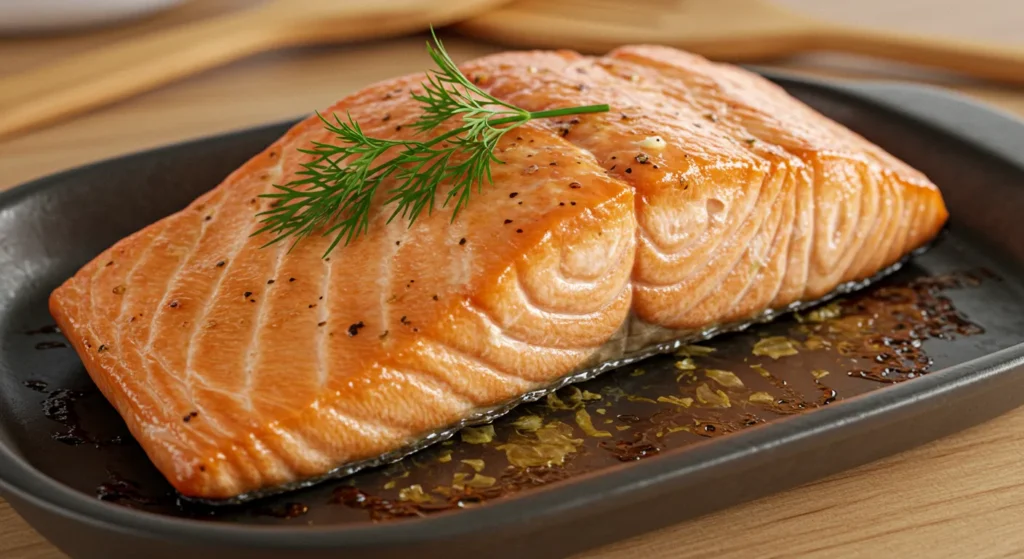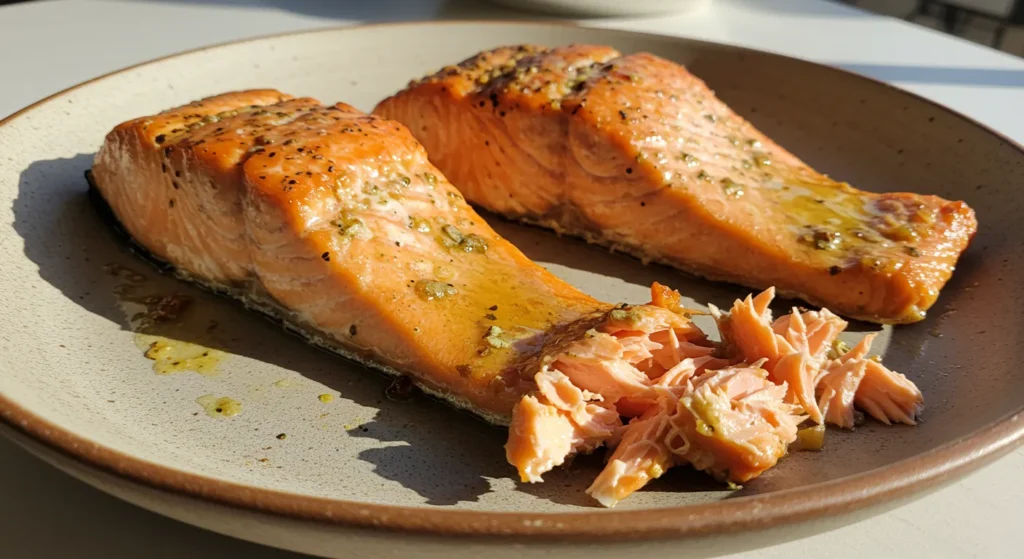
Table of Contents
I remember the first time I tried baked salmon. It was a cold evening in Seattle. My grandmother took a golden fillet out of the oven.
The kitchen smelled of herbs and lemon. It made a simple dish special. That moment started my love for baked salmon.
Baked salmon is more than food. It’s quick and easy to make in under 30 minutes. It’s perfect for busy people or those who want to impress.
In this guide, I’ll teach you about making tasty baked salmon. You’ll learn how to pick the right fillet and cook it well. You’ll make a healthy dish that tastes like it’s from a restaurant.
Key Takeaways
- Baked salmon takes only 5-15 minutes to prepare
- Rich in protein and omega-3 fatty acids
- Versatile dish with countless seasoning options
- Requires minimal cooking skills
- Nutritionally dense and heart-healthy meal
Understanding Different Types of Salmon
Exploring salmon is fun for seafood fans. Each type has its own taste and texture. This makes pescatarian meals exciting.
The Pacific Ocean has six salmon species. Five are caught by U.S. and Canadian boats. Let’s look at the most popular ones.
Sockeye Salmon: The Vibrant Catch
Sockeye salmon is known for its bright red-orange color. It tastes intense and is loved by chefs. It’s great for grilling and smoking.
- Bright red-orange color
- Intense, rich flavor profile
- Peak season: Late spring to September
- Ideal for grilling and smoking
King (Chinook) Salmon: The Luxury Option
Chinook salmon, or King salmon, is the most prized. It’s very fatty and tastes like butter. It’s available from late spring to early fall.
- Highest fat content among salmon species
- Buttery, rich flavor
- Thick, meaty flesh
- Available fresh from late spring to early fall
Coho Salmon: The Mild-Mannered Variety
Coho salmon, or silver salmon, tastes milder. It’s good for beginners. It’s available from June to September.
| Salmon Type | Fat Content | Flavor Profile | Best Cooking Method |
|---|---|---|---|
| Sockeye | High | Intense | Grilling, Smoking |
| King (Chinook) | Highest | Rich, Buttery | Baking, Grilling |
| Coho | Lower | Mild | Poaching, Baking |
Knowing about these salmon types helps you pick the best for your meals. It makes cooking pescatarian dishes fun.
Health Benefits and Nutritional Value
Salmon is a top choice for healthy food. It’s full of nutrients and is good for you. It’s also gluten-free, making it great for many diets.
Salmon has lots of good stuff in it. Here are some of its best points:
- Rich in omega-3 fatty acids
- High-quality protein source
- Excellent for heart and brain health
- Supports inflammation reduction
Salmon is also full of vitamins and minerals. Just one serving can give you lots of health benefits.
| Nutrient | Wild Salmon | Farmed Salmon |
|---|---|---|
| Calories (per 100g) | 182 | 206 |
| Protein (grams) | 25 | 22 |
| Vitamin B12 (% DV) | 127% | 117% |
| Omega-3 Fatty Acids (grams) | 2.2 | 2.3 |
“Salmon is nature’s multivitamin, delivering essential nutrients in every delicious bite.”
Doctors say we should eat seafood two times a week. Salmon is a great pick for healthy meals. It’s tasty and fits many diets.
Eating salmon means you’re choosing a food that’s good for your heart, brain, and health. It’s a smart choice for a healthy diet.
Essential Ingredients for Baked Salmon
Starting with the right ingredients is key to making tasty oven-baked fish. Baked salmon is a great choice for easy dinners. It needs the right mix of flavors and nutrients.
Fresh vs Frozen Salmon Selection
Choosing between fresh and frozen salmon matters. Fresh salmon tastes better and feels nicer. But, good frozen salmon is a great choice too.
- Fresh salmon benefits:
- Peak flavor
- Optimal texture
- Immediate availability
- Frozen salmon advantages:
- Longer storage time
- Often more affordable
- Convenient preservation
Essential Herbs and Seasonings
Seasoning is key to making your fish taste amazing. Mix herbs and spices that go well with salmon’s flavor.
| Herb/Seasoning | Quantity | Flavor Profile |
|---|---|---|
| Dill | 1 tsp | Fresh, light |
| Garlic Powder | 1 tsp | Robust, savory |
| Paprika | 1 tsp | Smoky, mild heat |
| Italian Seasoning | 1 tsp | Complex, herbal |
Flavor Enhancers
Boost your dinner with these extra flavors:
- Fresh lemon juice
- Melted butter (3 tablespoons)
- Kosher salt (¾ teaspoon)
- Black pepper
“The secret to perfect baked salmon lies in quality ingredients and thoughtful seasoning.” – Culinary Expert
Pro tip: Always check the salmon’s temperature with an instant-read thermometer. It should be 140°F for the best taste and safety.
How to Select the Perfect Salmon
Choosing the right salmon is key for tasty and healthy dishes. As a seafood lover, I’ve found that good salmon makes a big difference.
Here are important things to look for when buying salmon:
- Color and Appearance: Find salmon with bright colors, from deep orange to pink
- Texture: Look for firm flesh that feels springy when pressed
- Smell: Fresh salmon smells like the ocean, not strong or bad
For fresh salmon, check these things:
- Make sure the skin is shiny and wet
- Look for no brown spots or edges
- Check if the fish counter is known for freshness
“The quality of your salmon determines the success of your entire dish.” – Professional Chef Recommendation
For frozen salmon, check the packaging well. It should be sealed tight with no freezer burn. Look for vacuum-sealed packs for best quality.
Pro tip: Wild-caught salmon is usually better for you than farm-raised.
Preparation Techniques and Tips
Preparing salmon for baking needs careful steps. As a home cook, I’ve found ways to make sure your salmon is perfect every time.
Cleaning and Portioning
Start by rinsing the salmon under cold water. Then, dry it with paper towels to get rid of extra moisture. This helps the salmon cook better and makes seasonings stick.
- Remove any visible pin bones using tweezers
- Cut approximately 1 pound of salmon into four even fillets
- Aim for fillets weighing around six ounces each
Seasoning Methods
The right seasoning can make your salmon amazing. Try different flavors to keep your meals interesting.
| Seasoning Type | Flavor Profile | Best Used With |
|---|---|---|
| Simple Salt & Pepper | Classic, Mild | Fresh herbs, Lemon |
| Dry Rub | Intense, Concentrated | Cajun, Mediterranean Spices |
| Wet Marinade | Complex, Layered | Citrus, Soy-Based Marinades |
Marinade Options
Marinades add great flavor to salmon. For quick dinners, make marinades ahead of time. Mix olive oil, garlic, lemon juice, and herbs for a tasty salmon.
Pro tip: Always marinate salmon for no more than 30 minutes to prevent the acids from breaking down the delicate fish proteins.
With these tips, you can make salmon dishes like a pro. Keep it simple and let the salmon’s natural taste shine.
Baked Salmon: The Perfect Temperature and Timing

Learning to cook oven-baked fish is all about being precise. When you make salmon, getting the temperature and timing right is key. It makes a big difference in how good your meal tastes.
The FDA says to cook salmon to 145 degrees F for safety. But chefs often choose a bit lower for tender fish. They say different temperatures work for different doneness levels:
- Rare Salmon: Below 120°F
- Medium-Rare Salmon: 125-130°F
- Medium Salmon: 135-140°F (the best temperature)
- Well-Done Salmon: 145°F or higher
How long you cook fish depends on its thickness and how done you like it. Here’s a quick guide for different oven temperatures:
| Oven Temperature | 6-oz Fillet Cooking Time | Large Side Cooking Time |
|---|---|---|
| 350°F | 15-18 minutes | 20-25 minutes |
| 375°F | 12-16 minutes | 18-21 minutes |
| 400°F | 11-14 minutes | 15-18 minutes |
Pro tip: Always use a meat thermometer to check the fish’s temperature. Wild salmon cooks faster than farmed because it has less fat.
“The key to perfect oven-baked fish is watching the temperature, not just the clock.” – Culinary Expert
Thicker salmon fillets are easier to cook and less likely to dry out. For the best taste and moisture, aim for 135°F.
Simple Garlic Lemon Baked Salmon Recipe
Looking for easy dinner ideas that are both delicious and nutritious? This garlic lemon baked salmon is your perfect solution. It’s a healthy seafood dish that will impress your family and guests. I’ll show you a foolproof recipe that turns simple ingredients into a restaurant-quality meal.
Ingredients You’ll Need
- 2 pounds fresh salmon fillets
- 3 large lemons
- 5 chopped garlic cloves
- 3 tablespoons extra virgin olive oil
- 2 teaspoons dried oregano
- 1 teaspoon sweet paprika
- 1/2 teaspoon black pepper
Step-by-Step Cooking Instructions
- Preheat the oven to 375°F
- Place salmon on a lined baking sheet
- Drizzle olive oil over the fillets
- Sprinkle chopped garlic and seasonings
- Top with fresh lemon slices
- Bake for 15-20 minutes
- Finish under broiler for 3 minutes for crispy edges
Pro Tips for Perfect Salmon
Selecting high-quality salmon is key. Look for a vibrant pink hue and a fresh smell. Wild or sustainably-farmed salmon works best. For the most tender results, aim for an internal temperature between 125-135°F, which provides a perfect medium doneness.
Pro tip: Always let your salmon rest for 3-5 minutes after cooking to retain maximum juiciness!
This recipe serves 4 and takes about 30 minutes to make. Each serving has a lot of protein and very little carbs.
Flavor Variations and Seasoning Combinations
Exploring salmon recipes is fun. You don’t have to stick to just one flavor. Baked salmon can become a culinary adventure with the right seasonings.

Here are some favorite flavor combinations to make your salmon special:
- Asian-Inspired Teriyaki: Mix soy sauce, ginger, and honey for a sweet glaze
- Mediterranean Herb Blend: Use oregano, thyme, rosemary, and lemon zest for a bright taste
- Spicy Cajun Rub: Blend paprika, cayenne, garlic powder, and black pepper for a bold flavor
- Maple Mustard Glaze: Whisk Dijon mustard and maple syrup for a tangy-sweet coating
When trying new salmon recipes, remember to balance flavors. Start with a little seasoning and adjust as needed. Some great dry rub ingredients include:
- Brown sugar (1 tablespoon)
- Chili powder (2 teaspoons)
- Lemon zest (1 teaspoon)
- Smoked paprika (½ teaspoon)
“Cooking is an art, and salmon is your canvas. Don’t be afraid to experiment!” – Chef’s Wisdom
Pro tip for pescatarian meals: Let your salmon rest for 5 minutes after cooking. This helps keep the flavor and moisture in.
Proper Storage and Leftover Ideas
Storing your baked salmon right is key for great meal prep and dinner ideas. After cooking, let the salmon cool to room temperature in 2 hours. This stops bacteria from growing. Store it in a sealed container in the fridge for 3-4 days.
Leftover salmon opens up a world of tasty options. Here are some ideas:
- Salmon salad sandwiches
- Salmon fried rice
- Mixed green salads with flaked salmon
- Scrambled eggs with salmon chunks
Pro tip: Avoid reheating salmon in the microwave, as it can dry out the fish and create unpleasant odors. Instead, gently warm it in the oven at 275°F for about 15 minutes.
“Leftover salmon is a culinary opportunity, not a problem!” – Chef’s Kitchen Wisdom
To freeze cooked salmon, put it in a freezer-safe container. Use it within 3 months for best taste and texture. To thaw, put it in the fridge for about 6 hours.
| Storage Method | Duration |
|---|---|
| Refrigerator | 3-4 days |
| Freezer | Up to 3 months |
By following these tips, you’ll reduce waste and get creative with salmon. Enjoy your meal prep and dinner ideas!
Recommended Side Dishes
Making a great meal is more than just the main dish. When you serve baked salmon, picking the right sides makes it even better. I’ll show you tasty sides that go well with gluten-free proteins.
Vegetable Pairings
Vegetables are key to a good meal. Here are some great choices:
- Roasted asparagus with garlic
- Lemon Parmesan green beans
- Honey-glazed baby carrots
- Crispy Brussels sprouts
Grain Accompaniments
Looking for something more filling? Try these grain sides:
- Quinoa pilaf
- Wild rice blend
- Herbed couscous
- Cauliflower rice (gluten-free option)
Sauce Suggestions
Make your salmon even better with these sauces:
- Dill and yogurt sauce
- Lemon butter sauce
- Chimichurri
- Garlic aioli
| Side Dish Category | Preparation Time | Serving Size |
|---|---|---|
| Vegetable Sides | 10-20 minutes | 4-6 people |
| Grain Accompaniments | 15-30 minutes | 4-6 people |
| Sauces | 5-10 minutes | 4-6 people |
Pro tip: Choose sides that complement the salmon’s rich flavor without overpowering it.
With these ideas, you’ll make a meal that’s both tasty and healthy.
Conclusion
We’ve explored how to make tasty baked salmon. It turns your kitchen into a fancy seafood spot. Baked salmon is both healthy and yummy, making your cooking better.
Baked salmon is more than just food. It lets you get creative with flavors. By controlling temperature and picking the right ingredients, you can make amazing dishes.
Start with the basics and then add your own twist. Baked salmon is great for any meal, from a quick dinner to a special occasion. The more you cook it, the better you’ll get.
Start your baked salmon journey and enjoy the learning. Your cooking will get better, making meals that are good for you and taste great.
FAQ
What type of salmon is best for baking?
King (Chinook) or Sockeye salmon is best. They have lots of fat and taste rich. They stay moist and flaky when baked.
How long should I bake salmon in the oven?
Baking time varies by salmon thickness. Bake at 400°F for 12-15 minutes. Use a thermometer to check for 145°F.
Can I freeze baked salmon?
Yes, you can freeze it. Store in airtight containers or bags for 3 months. Thaw in the fridge and reheat gently.
What are the health benefits of eating salmon?
Salmon is very healthy. It has omega-3s, protein, and nutrients for heart and brain health. It’s great for pescatarians and those avoiding gluten.
How do I know if salmon is fresh?
Look for bright color, firm flesh, and a mild smell. Avoid strong smells or discoloration. Ask about the catch date at the fish counter.
What are some easy marinades for baked salmon?
Try garlic-lemon, honey-soy, or herb-olive oil. A mix of olive oil, lemon, garlic, and dill is tasty. For Asian flavors, use teriyaki or ginger-sesame.
Can I bake frozen salmon directly?
It’s possible but thawing is better. It cooks more evenly and keeps texture. If frozen, cook longer and check the temperature.
What are good side dishes to serve with baked salmon?
Serve with roasted veggies, quinoa, brown rice, or a green salad. For more, try roasted sweet potatoes or light risotto.

